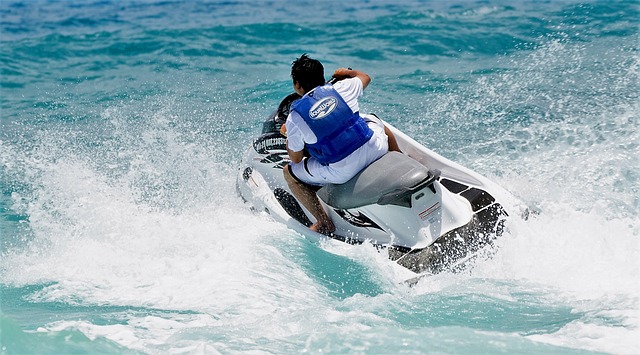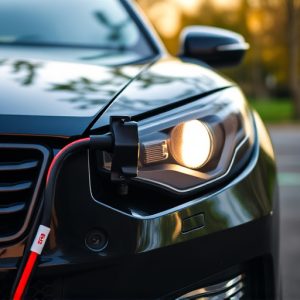7 Strategies to Minimize Environmental Impact of Boat Batteries
The article delves into the environmental impact of traditional lead-acid boat batteries and the importance of transitioning to more sustainable alternatives like lithium or AGM batteries to mitigate pollution risks. It highlights the necessity for stringent regulations and community initiatives to…….

The article delves into the environmental impact of traditional lead-acid boat batteries and the importance of transitioning to more sustainable alternatives like lithium or AGM batteries to mitigate pollution risks. It highlights the necessity for stringent regulations and community initiatives to ensure responsible recycling and proper disposal of used boat batteries, thereby safeguarding aquatic ecosystems from heavy metal leakage. The discussion underscores the role of education in promoting sustainable practices among boat owners, including regular maintenance to extend battery life, strategic energy use, and the integration of renewable energy sources like solar panels. By adopting these eco-conscious approaches, the boating community can significantly reduce its environmental footprint, contributing to the preservation of our marine environments for future generations. Keywords such as "boat battery" are strategically placed throughout the content to ensure relevance and visibility on topics related to maritime sustainability.
7 Tips to Mitigate Battery Pollution Impact from Boats
Boat batteries play a critical role in maritime activities, powering everything from navigation systems to onboard entertainment. However, their improper disposal and the environmental repercussions of their pollutants have become pressing concerns. This article delves into practical strategies for reducing the ecological footprint left by boat batteries, ranging from selecting eco-conscious battery types to embracing renewable energy solutions. By understanding the impact, adopting best practices in maintenance and disposal, and staying informed on regulations, we can collectively protect our aquatic environments. Join us as we navigate through sustainable boating practices, highlighting community initiatives and educational efforts that are pivotal in stewarding boat batteries responsibly.
- Understanding the Environmental Impact of Boat Batteries
- Opt for Eco-Friendly Boat Battery Types
- Proper Disposal and Recycling Practices for Old Boat Batteries
- Maintenance Best Practices to Extend Boat Battery Lifespan
- Energy Efficiency: Smart Usage of Boat Battery Power
- Investing in Solar Panels and Renewable Energy Sources for Boats
- The Role of Regulations in Mitigating Battery Pollution from Boats
- Community Initiatives and Education on Boat Battery Stewardship
Understanding the Environmental Impact of Boat Batteries

The environmental impact of boat batteries is a critical issue that has garnered increasing attention from marine conservationists and environmentally conscious individuals. Traditional lead-acid boat batteries contain lead, an highly toxic substance that can leach into waterways when discarded, posing significant risks to aquatic life and ecosystems. As these batteries degrade, the lead and other harmful substances they contain can seep into the soil and eventually find their way into rivers, lakes, and oceans, disrupting ecological balance and potentially entering the food chain. This pollution not only affects wildlife but also has the potential to contaminate drinking water sources, highlighting the need for sustainable battery solutions in the maritime sector.
The transition to more environmentally friendly boat batteries, such as those using absorbed glass mat (AGM) or lithium-ion technology, offers a pathway to mitigate this pollution. These advanced battery types are not only lighter and more efficient but also significantly reduce the environmental footprint associated with their disposal. For instance, lithium-ion batteries contain no toxic metals like lead, mercury, or cadmium, thus eliminating the risk of heavy metal contamination. As the demand for eco-friendly boating options grows, the market is responding with innovative battery solutions that are not only better for the environment but also offer enhanced performance and longevity. Boat owners and manufacturers alike play a pivotal role in this shift, as responsible stewardship of the world’s waterways depends on the collective effort to minimize pollution through thoughtful choices in battery technology.
Opt for Eco-Friendly Boat Battery Types

When selecting a battery for your marine vessel, it’s crucial to consider the environmental footprint associated with its use. Traditional lead-acid batteries have long been the standard in the boating industry due to their reliability and cost-effectiveness. However, these batteries contain sulfuric acid and antimony, which can be harmful to aquatic ecosystems if they leak or are disposed of improperly. As a more sustainable alternative, eco-friendly boat battery types such as lithium-ion and AGM (Absorbent Glass Mat) batteries offer significant advantages. Lithium-ion batteries, for instance, boast a longer lifespan, higher energy density, and greater efficiency than their lead-acid counterparts. They are also lighter in weight, which can improve your boat’s performance. AGM batteries, while not as light as lithium-ion, provide excellent deep cycle capabilities without the risk of spilling or leaking, making them a safer choice for the environment. By choosing eco-friendly boat batteries, boat owners contribute to reducing battery pollution impacts, ensuring that their passion for the water does not come at the expense of its health. It’s important to evaluate your specific needs and select a battery type that aligns with both your vessel’s requirements and your environmental values. With advancements in technology and increased awareness of the importance of sustainability, eco-friendly boat batteries represent a positive step towards minimizing the ecological impact of boating activities.
Proper Disposal and Recycling Practices for Old Boat Batteries

When a boat’s voyage comes to an end, the responsibility for its batteries doesn’t. Old boat batteries, brimming with heavy metals like lead and acid, are not ordinary trash; they require special attention during disposal to prevent environmental contamination. Proper disposal involves contacting local waste management facilities or specialized recycling centers that handle hazardous materials. These facilities are equipped to safely process the batteries, extracting reusable components and ensuring that harmful substances are neutralized in compliance with environmental regulations. By taking this step, you not only protect waterways from acidic leaks and metal contamination but also contribute to conserving natural resources. Recycling a boat battery can salvage up to 60-75% of its components, which are then used to manufacture new batteries. This practice extends beyond mere compliance; it’s a proactive measure in mitigating the environmental impact of marine battery pollution. Always check with local authorities or trusted recycling centers for guidelines on how to dispose of your boat battery responsibly, ensuring that you contribute positively to the health of our waterways and environment. It’s crucial to remember that the lifecycle of a boat battery doesn’t end at its useful service life; it continues through the responsible disposal and recycling process, where each component is accounted for with environmental stewardship in mind.
Maintenance Best Practices to Extend Boat Battery Lifespan

Regular maintenance of your boat battery is pivotal in extending its lifespan and ensuring optimal performance. To begin with, always keep your boat battery clean and dry. The presence of corrosion on terminals and connectors can significantly impede electrical flow, thus reducing the battery’s efficiency. Use a wire brush to gently remove any corrosion, and apply dielectric grease to the posts and connections to prevent future corrosion. Additionally, regularly check and maintain proper fluid levels in lead-acid batteries; for sealed or maintenance-free batteries, monitor the case temperature as overheating can compromise battery health.
Monitoring battery charge levels is another critical aspect of care. Avoid overcharging, which can damage the battery and reduce its lifespan. Chargers with automatic voltage regulation and built-in battery temperature compensation are recommended to maintain the ideal charging conditions. Further, it’s crucial to store your boat in a cool, dry place, away from direct sunlight or extreme temperatures, as these conditions can accelerate battery aging. Lastly, periodic load testing can identify issues before they lead to failure, ensuring your boat battery remains reliable for all your nautical adventures. Implementing these maintenance best practices not only extends the life of your boat battery but also ensures it operates at its peak efficiency throughout its service life.
Energy Efficiency: Smart Usage of Boat Battery Power

When considering the environmental impact of marine vessels, the role of boat batteries in pollution mitigation cannot be overstated. Traditional lead-acid batteries have long been a staple in the boating community, but their heavy metals and toxic substances pose significant ecological risks if improperly disposed of or leaked into waterways. The transition to more sustainable options like lithium or AGM (Absorbent Glass Mat) batteries is crucial for reducing this pollution. These modern alternatives are not only more environmentally friendly at the end of their lifecycle but also tend to be more energy-efficient, lasting longer and providing better performance, which translates to less waste and reduced environmental footprint.
Embracing energy efficiency starts with smart usage of boat battery power. Boaters can significantly reduce their environmental impact by adopting practices that conserve energy. This includes using energy-efficient appliances and lighting on board, minimizing the use of high-draw electrical components, and ensuring all batteries are properly maintained and charged. Additionally, utilizing solar panels or wind turbines to supplement battery power can further lessen reliance on fossil fuels and minimize the carbon footprint associated with boating. By being mindful of energy consumption and investing in sustainable technologies, boaters can play a pivotal role in preserving the health of our aquatic ecosystems and the beauty of our natural waterways.
Investing in Solar Panels and Renewable Energy Sources for Boats

When considering measures to mitigate the environmental impact of battery pollution, particularly in maritime contexts, investing in solar panels and renewable energy sources for boats emerges as a prudent step. Boat batteries, traditionally reliant on lead-acid technology, can pose significant ecological risks if not properly managed. By integrating solar panels into your vessel’s design, you harness clean, abundant sunlight to power your boat’s electrical systems, thereby reducing the strain on conventional batteries and lessening the likelihood of pollutants leaching into aquatic environments. This transition not only contributes to the health of our oceans but also promotes energy independence and cost savings over time.
Moreover, the adoption of renewable energy sources for boats is not just an environmental imperative but also a technological opportunity. Advanced solar panel setups can be customized based on the boat’s size, usage patterns, and energy requirements. These systems often include additional components like charge controllers and deep-cycle batteries designed to work in harmony with the solar array. By carefully selecting and installing these components, boat owners can ensure a reliable power supply that is both sustainable and eco-friendly. This investment not only aligns with the global shift towards green energy but also positions individuals as stewards of the sea, taking proactive steps to preserve its beauty and vitality for future generations.
The Role of Regulations in Mitigating Battery Pollution from Boats

The deployment of boats equipped with traditional lead-acid batteries poses significant environmental risks due to the heavy metals they contain, which can leach into waterways and cause pollution. Regulations play a pivotal role in mitigating this impact by setting standards for the design, manufacturing, and disposal of boat batteries. These regulations often mandate the use of more sustainable options such as sealed lead-acid batteries or alternative technologies like lithium-ion, which are less toxic and have a reduced environmental footprint. By enforcing stricter environmental controls and encouraging innovation in battery technology, regulatory frameworks can significantly minimize the pollution associated with maritime activities. This is particularly crucial in coastal regions and sensitive aquatic ecosystems where the ecological impact of pollutants can be severe. Moreover, regulations that facilitate the proper recycling and disposal of used boat batteries ensure that hazardous materials are handled responsibly, further reducing the risk of pollution. These measures not only protect the environment but also promote the sustainable use of resources, aligning with global efforts to combat environmental degradation and preserve aquatic habitats for future generations.
Community Initiatives and Education on Boat Battery Stewardship

Engaging community initiatives and education are pivotal in fostering responsible stewardship of boat batteries, which are a significant source of pollution. Local organizations can lead by example by organizing collection events for old or damaged boat batteries, ensuring they are recycled properly to prevent harmful substances from seeping into waterways. These initiatives not only address the environmental impact but also raise awareness about the importance of proper battery disposal among recreational boating enthusiasts. By providing clear information on how to dispose of batteries correctly and the environmental consequences of improper handling, communities can significantly reduce the pollution footprint associated with marine batteries.
Education programs aimed at boat owners can be particularly effective in promoting sustainable practices. These programs can include workshops on the proper maintenance of boat batteries, which can extend their life and reduce the frequency of disposal. Additionally, they can offer guidance on locating nearby recycling facilities that handle boat batteries with care. By empowering boat owners with knowledge and practical resources, these educational efforts contribute to a culture of sustainability within the boating community. This proactive approach not only mitigates the environmental impact of boat batteries but also encourages a sense of responsibility among individuals who use these batteries daily.
Boat batteries play a significant role in modern maritime activities, and their proper management is crucial for environmental health. This article has outlined seven actionable tips that can help mitigate the pollution impact of these batteries. From selecting eco-friendly options and adhering to responsible disposal practices to embracing renewable energy sources like solar panels and engaging with community initiatives, there are tangible steps boat owners can take. Understanding the environmental footprint of batteries and committing to maintenance best practices will not only protect our waterways but also contribute to sustainable recreation on the water. By implementing these tips, we can all contribute to a cleaner, more responsible future for boating and beyond.







